Photo: Kevin Winter/Getty Images
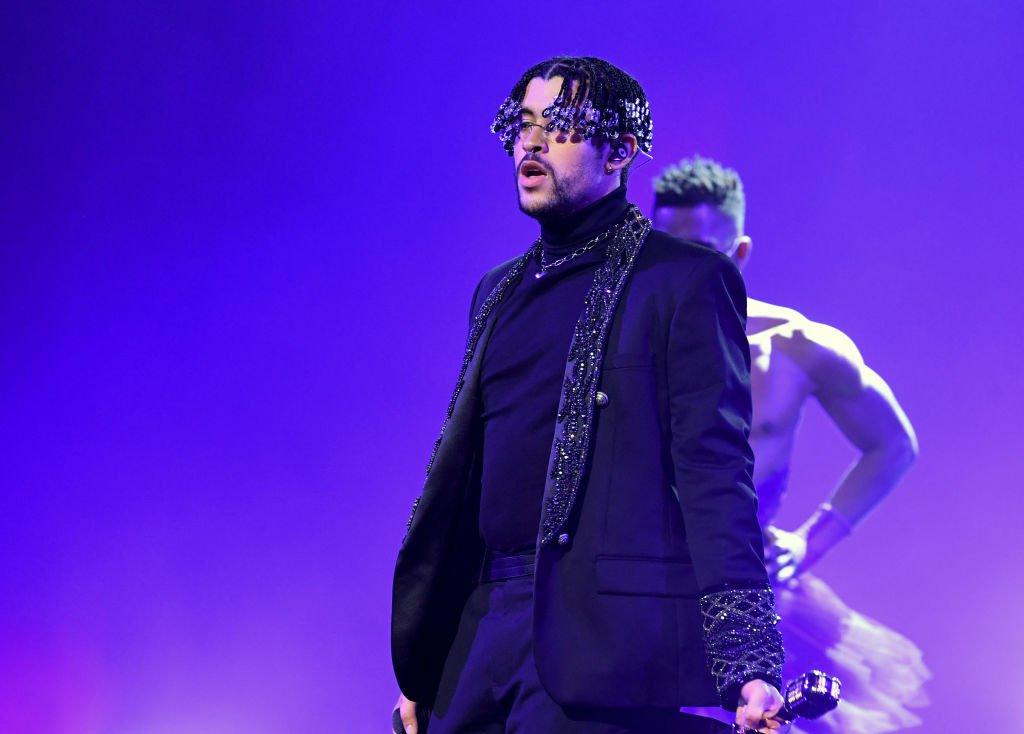
news
Bad Bunny Wins Best Reggaeton Performance for "Yo Perreo Sola" | 2020 Latin GRAMMYs
The singer/rapper takes home Best Reggaeton Performance at the 21st Latin GRAMMY Awards
**Bad Bunny **won Best Reggaeton Performance for "Yo Perreo Sola" at the 21st Latin GRAMMY Awards. This marks his second career Latin GRAMMY win and first win of the evening. This is the first time this award category has been presented by the Latin Recording Academy.
The empowering dance track, "Yo Perreo Sola," (or, I dance alone) is from Bad Bunny's first of two albums of 2020,YHLQMDLG. The album is up for Album Of The Year and Best Urban Music Album. His 2019 collab LP with J Balvin, Oasis, is also in the running for those two categories. The Puerto Rican superstar received a total of nine 2020 Latin GRAMMY nominations.
His win bested fellow nominees J Balvin**; DJ Snake** and J Balvin with Tyga; Feid and Justin Quiles; Guaynaa with Cauty; Ozuna and Sech; and Ozuna*.*
file: social: https://twitter.com/badbunnyinfope/status/1329525940800643072
Things are just getting started! Tune in to the 2020 Latin GRAMMY Awards at 8 p.m ET / PT tonight on Univision to watch Bad Bunny perform, among many other stellar musical numbers and some big category wins.
Check out all the complete 2020 Latin GRAMMY nominees and winners list here.
For more information on the Latin GRAMMYs and Latin Recording Academy, please visit latingrammy.com.
<style>.embed-container { position: relative; padding-bottom: 56.25%; height: 0; overflow: hidden; max-width: 100%; } .embed-container iframe, .embed-container object, .embed-container embed { position: absolute; top: 0; left: 0; width: 100%; height: 100%; }</style><div class='embed-container'><iframe src='https://www.youtube.com/embed//GtSRKwDCaZM' frameborder='0' allowfullscreen></iframe></div>
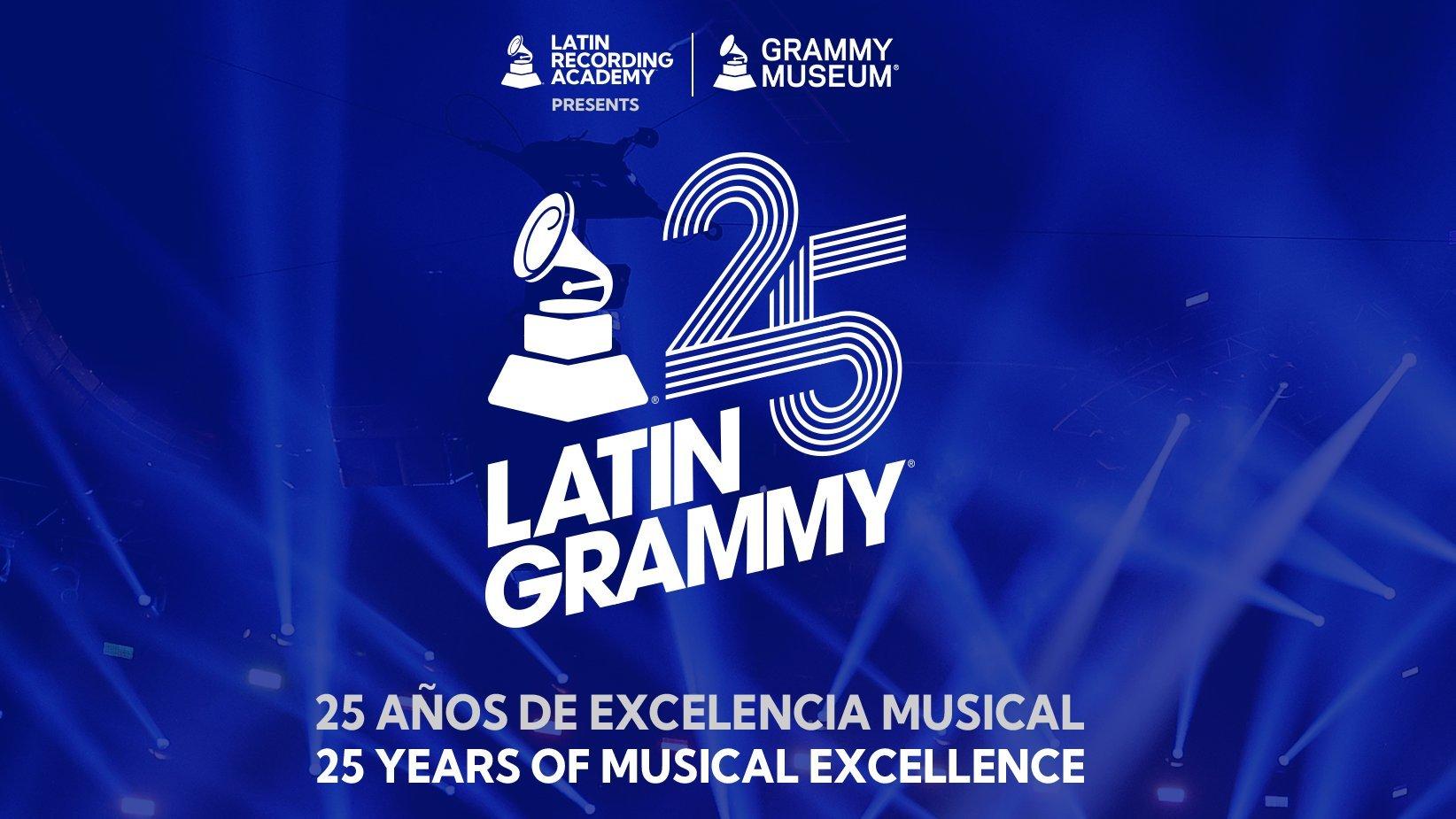
news
New Latin Recording Academy Exhibits In New York, Los Angeles & Miami To Celebrate The 25th Anniversary Of The Latin GRAMMYs: Launching September 2024
Artifacts from Latin GRAMMY winners and nominees, along with original artwork, will be displayed at the Paley Museum in New York City, the GRAMMY Museum in Los Angeles, and the Gary Nader Art Centre in Miami.
In celebration of the 25th anniversary of the Latin GRAMMYs, the Latin Recording Academy has announced a series of exhibits for 2024 at the Paley Museum in New York City, the GRAMMY Museum in Los Angeles, and the Gary Nader Art Centre in Miami.
"For 25 years we have had the immense privilege of celebrating excellence in Latin music, accompanying our music creators in their successes worldwide. These exhibits are a magnificent opportunity to bring the magic of the Latin GRAMMYs to the public," said Manuel Abud, CEO of the Latin Recording Academy. "We invite all music lovers to join us in New York City, Los Angeles and Miami to enjoy these exhibits, which are filled with unforgettable moments and important achievements that have marked our history."
The 2024 Latin GRAMMYs, officially known as the 25th Annual Latin GRAMMY Awards, will air live from the Kaseya Center in Miami on Thursday, Nov. 14. The three-hour telecast, produced by TelevisaUnivision, the world's leading Spanish-language media and content company, will broadcast live on Univision, Galavisión, and ViX on Thursday Nov. 14, beginning at 8 p.m. ET/PT (7 p.m. CT), with a one-hour pre-show starting at 7 p.m. ET/PT. This year’s nominees will be announced on Tuesday, Sept. 17.
This year, the Latin GRAMMYs will debut a new Field and two new Categories: Best Latin Electronic Music Performance, housed within the new Electronic Music Field, and Best Contemporary Mexican Music Album (Regional-Mexican Field). Ahead of the 2024 Latin GRAMMYs, the Latin Recording Academy will host the official Latin GRAMMY Week 2024, which includes multiple events throughout Miami-Dade County including the 2024 Latin Recording Academy Person of the Year gala, which this year honors 18-time Latin GRAMMY winner and two-time GRAMMY winner Carlos Vives.
Learn more about the new Latin Recording Academy exhibits taking place in New York City, Los Angeles and Miami below:
The Paley Museum, New York City
Sept. 13 - Nov. 3
The Latin GRAMMYs kick-off exhibit at the Paley Museum showcases the remarkable 25-year history of Latin music, celebrating the vibrant cultural tapestry that has shaped the awards show into a global phenomenon. Visitors can explore priceless artifacts, glamorous costumes, and iconic instruments from music superstars like Ricky Martin, Rosalía, Carlos Santana, and Shakira — all Latin GRAMMY and GRAMMY winners — as well as celebrated New Yorkers such as Celia Cruz and Rúben Blades, whose influence has left an indelible mark on the music world. The exhibit will highlight some of the most unforgettable moments from the Latin GRAMMY Awards telecast, trace the show’s incredible evolution, and demonstrate why Latin music has become an essential part of our culture.
"It is a tremendous honor to partner with the Latin Recording Academy and to have the privilege of hosting this historic 25th anniversary celebration of the Latin GRAMMY Awards at the Paley Center," said Maureen J. Reidy, President & CEO of The Paley Center for Media. "This must-see exhibit will honor the indelible impact of Latin music and its visionary artists, whose innovative rhythms, poignant lyrics, and extraordinary contributions have redefined the global musical landscape and have had a profound impact not only on music but on entertainment and culture worldwide."
GRAMMY Museum, Los Angeles
Sept. 19 - Dec. 18
Hosted on the 2nd floor of the GRAMMY Museum as part of its permanent Latin Music Gallery, this exhibit will enhance the museum's extensive Latin aisle by featuring artifacts from global Latin superstars like Shakira, Carlos Santana, Karol G, and Rosalía, among others. The exhibit will explore the last 25 years of Latin GRAMMY history and the diverse musical genres and cultures that have graced its stage.
At its core, the exhibit underscores how Latin music has evolved into a powerful commercial force in the international music landscape over the past quarter-century, with the Latin GRAMMYs playing a pivotal role in its global rise. The exhibit will also explore the history of the institution and its most significant moments, highlighting Latin music's creative complexity and enduring cultural impact.
"The Latin GRAMMYs have undeniably established themselves as a cultural landmark and a powerful influence in global music over the past 25 years," said Michael Sticka, President and CEO of the GRAMMY Museum. "This fall, we eagerly anticipate commemorating more than two decades of musical excellence, memorable highlights, and extraordinary moments from the Latin GRAMMYs at the GRAMMY Museum."
Gary Nader Art Centre, Miami
Sept. 26 - Dec. 20
Miami will host a first-of-its-kind collection of 25 years of Latin GRAMMY official art, featuring original paintings by renowned artists including Romero Britto, Walter Goldfarb, Michael V. Rios — who also designed the cover of Carlos Santana’s multi-GRAMMY-winning album Supernatural —and Patssi Valdez, among others. From mixed media to collage, murals and oil paintings, the collection includes renowned visual artists from several countries. In addition,Brazilian muralist Aline Bispo, the official artist for the 24th Annual Latin GRAMMY Awards, will unveil a new piece to inaugurate the festivities.
"It is a profound honor to host the art exhibition commemorating the Latin GRAMMYs at our gallery in Miami. This city, with its vibrant culture and deep Latin roots, is the perfect setting to celebrate the rich heritage and artistic achievements of Latin music. We are thrilled to bring together art and music in such a dynamic fashion, highlighting the synergy between these two powerful expressions of creativity," said Gary Nader, founder of the Gary Nader Art Centre.
The Latest News About Latin Music

Los Lonely Boys Resurrected: The Sibling Rockers Talk Their New Album, Return To The Road & Family Magic

On 'Mirada,' Ivan Cornejo Redefines The Sound Of Sad Sierreño And Helps Fans Heal Through Music
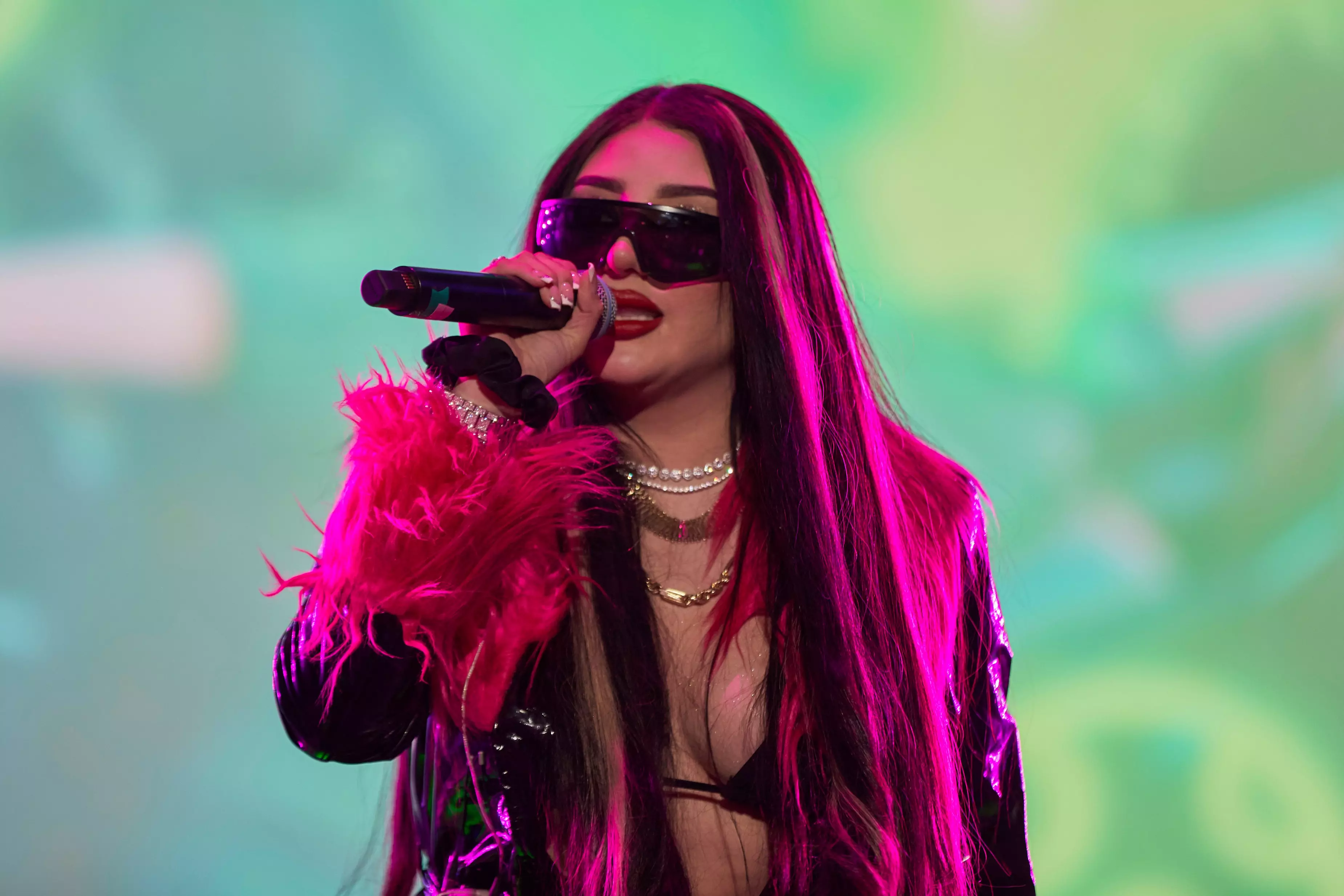
7 Artists Bringing Reggaeton Mexa To The World: El Malilla, Bellakath & More

Revisiting 'Re': How Café Tacvba’s 1994 Masterpiece Changed Mexican Music Forever
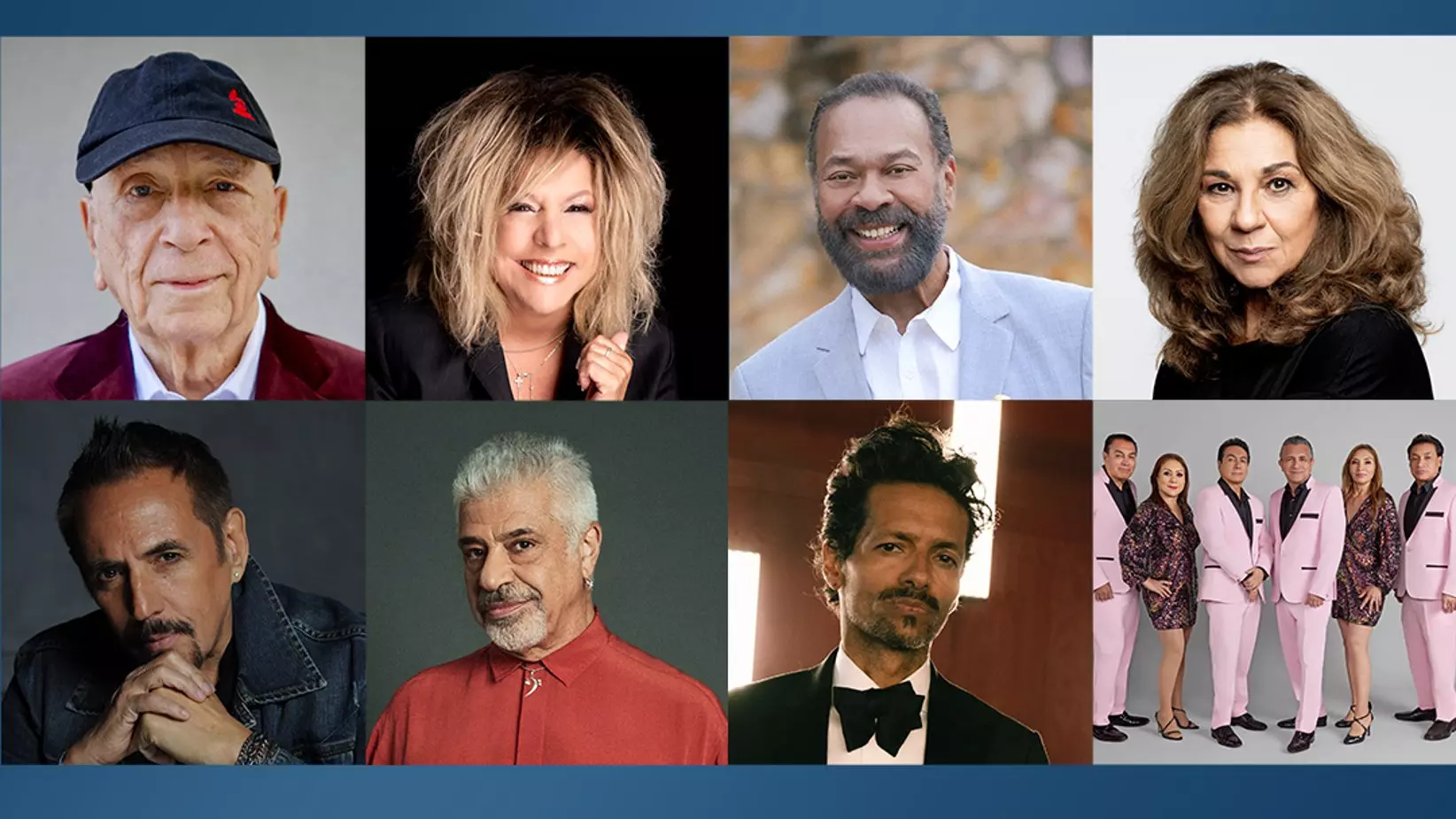
The Latin Recording Academy Announces 2024 Special Awards Recipients: Los Ángeles Azules, Draco Rosa, Albita, Lolita Flores & More
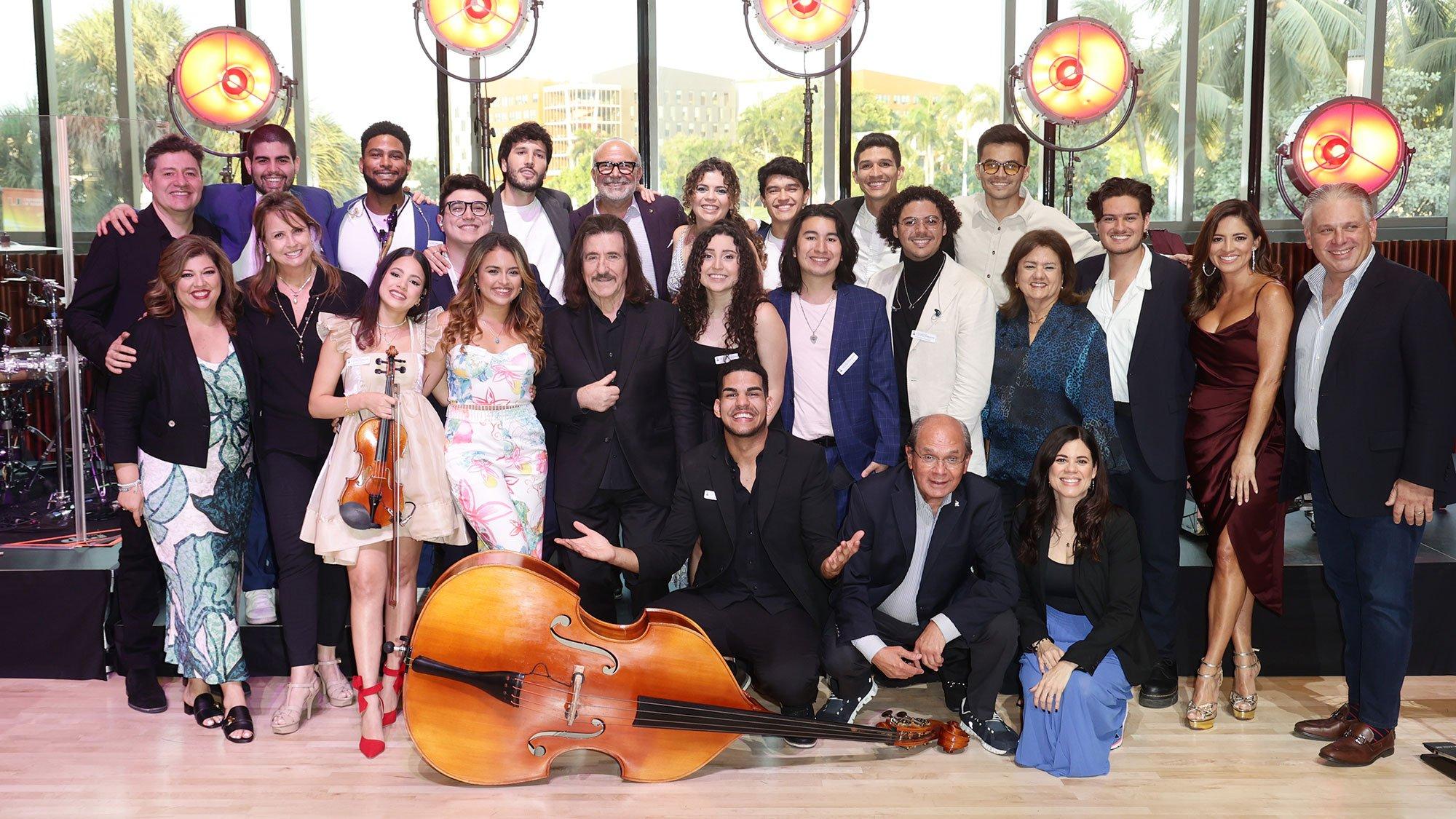
Photo: John Parra/Getty Images for The Latin Recording Academy
news
Latin GRAMMY Cultural Foundation Awards Prodigy Scholarship To Leo Luna Roblejo & Announces More Tuition Scholarship Recipients
The Sebastián Yatra Scholarship has been awarded to Cuban double bass player Leo Luna Roblejo. An additional 43 students will receive tuition assistance through Gifted Tuition, Tuition Assistance, Bulova and Gibson Gives scholarships.
On Aug. 7, the Latin GRAMMY Cultural Foundation awarded the Sebastián Yatra Scholarship to Cuban double bass player Leo Luna Roblejo during a special ceremony in Miami.
The event — hosted by award-winning journalist Pamela Silva and sponsored by Loud And Live as part of their $1 million commitment over five years — featured performances by Yatra, a Latin GRAMMY winner and GRAMMY nominee, alongside Luna Roblejo, and additional scholarship recipients and alumni.
Also known as the Prodigy Scholarship, the Sebastián Yatra Scholarship was created 10 years ago to support music education and Latin music genres. It is sponsored annually by a Latin music icon and holds a maximum value of $250,000. Scholarship funds will allow Luna Roblejo to pursue a bachelor's degree at Berklee College of Music in Boston, beginning this fall.
In addition, the scholarship supports the costs of tuition, room, board and wrap-around services that include ongoing mentorship and learning opportunities provided in partnership with the Latin GRAMMY Cultural Foundation. Previous sponsors include: Nicky Jam (2023), Sofia Carson (2022), Juanes (2021), Julio Iglesias (2020), Emilio and Gloria Estefan (2019), Carlos Vives (2018), Miguel Bosé (2017), Juan Luis Guerra (2016) and Enrique Iglesias (2015).
Luna Roblejo, who resides in Miami, was selected by the Foundation's Scholarship Committee from a highly competitive group of hundreds of applicants worldwide.
"It is with immense pride that we bestow our tenth Prodigy Scholarship as we continue to celebrate a decade of the Foundation’s unwavering mission to support and cultivate the next generation of Latin music creators," said Raquel "Rocky" Egusquiza, Executive Director of the Latin GRAMMY Cultural Foundation. "We are profoundly grateful for the generosity of respected artists such as Sebastián Yatra that provides these talented musical students the opportunity to follow their dreams and carry forward the rich legacy of Latin music."
Since its establishment, the Latin GRAMMY Cultural Foundation has committed an extraordinary sum of more than $10 million in scholarships, grants, musical instruments, and educational programs throughout the United States and Ibero-America.
"Being a part of this incredible initiative alongside the Latin GRAMMY Cultural Foundation, which supports young people on their journey to fulfill their dreams in music, is an honor," shared Yatra. "Music has the power to change lives and unite cultures, and I am excited to see how these young people, like Leo, will carry forward the legacy of Latin music with passion and dedication. I am grateful for the opportunity to contribute to their education and artistic development."
"Music has been my calling and my passion ever since I was a young child, and to have the opportunity to pursue my dream thanks to the support of Sebastián Yatra and the incredible Latin GRAMMY Cultural Foundation is beyond anything I could have imagined," said Luna Roblejo. "I am committed to making you all proud, and I will take full advantage of this opportunity, working hard every day to make the most of this gift."
The Foundation also announced the recipients of its annual Gifted Tuition, Tuition Assistance, Bulova and Gibson Gives scholarships — with additional funds from First Horizon and the Arturo Sandoval Institute — that award 43 talented students from diverse backgrounds the opportunity to pursue an education at some of the most prestigious music institutions in the world.
Gifted Tuition Scholarship Recipients
The following three students will each receive the Gifted Tuition Scholarship, with a maximum value of $120,000, which will support the tuition costs of four years of study at the university, college or music institution of their choice, including wrap-around services provided by the Foundation. The recipients are:
Abraham Jiménez Sánchez, pianist from the Dominican Republic
Marcos Castilla Jiménez, pianist from Spain
Melany Fiorella Cisneros Fernández, bass player from Peru
Tuition Assistance, Bulova And Gibson Gives Scholarship Recipients
In addition, the 40 students below will each receive the Tuition Assistance Scholarship, a one-time scholarship with a maximum value of $12,500. This scholarship can be used toward tuition costs at the university or college of their choice and includes wrap-around services provided by the Foundation.
Bulova will sponsor one Tuition Assistance Scholarship, while Gibson Gives — Gibson's philanthropic division — will sponsor three Tuition Assistance Scholarships of up to $12,500 each. Gibson Gives will also gift a Gibson or Epiphone instrument to students pursuing a music education with electric or acoustic guitar as their principal instrument.
| NAME | INSTRUMENT | COUNTRY | COLLEGE/UNIVERSITY |
|---|---|---|---|
| Andrés Felipe Palacios | Guitar | Colombia | Peabody Institute of The Johns Hopkins University |
| Pedro Henrique Cheik Costantin | Guitar | Brazil | Faculdade de Música Souza Lima |
| Pedro Secco | Guitar | Brazil | Berklee College of Music |
| Adrian Delgado | Piano | Venezuela | Berklee College of Music |
| Alberto Barba | Piano | Spain | Manhattan School of Music |
| Andrés Guerra | Guitar | Venezuela | Mannes School of Music at The New School |
| Carla Chiang | Piano | Dominican Republic | Berklee College of Music |
| Carlos Chacon | Violin | Venezuela | Roosevelt University |
| Cobe Isai Banda Salcido | Guitar | Mexico | Tecnológico de Monterrey, México |
| Cristian Tamblay | Drum Set | Chile | New York University |
| Daniel Olivero | Voice | Venezuela | Art House Academy |
| Dora Oliva Devoghel | Violin | Venezuela | New England Conservatory |
| Eduardo de Abreu Moro | Guitar | Brazil | New York University |
| Estevan Olmos | Percussion | United States | University of Southern California |
| Filipe Gomes da Silva | Trombone | Brazil | Faculdade de Música Souza Lima |
| Franco Dilmé Romero | Saxophone | Cuba | University of North Carolina Greensboro |
| Guillermo Wan | Bass | Ecuador | Berklee College of Music |
| Héctor Moreno Guerrero | Piano | Dominican Republic | Berklee College of Music |
| João Vítor Aredes Martins Paulo | Drum Set | Brazil | Faculdade de Música Souza Lima |
| Juan Bautista Saus Ruiz | Saxophone | Spain | Eastman School of Music |
| Juan Diego Alvan Madueño | Piano | Peru | Los Angeles College of Music |
| Laia Martínez Gelabert | Bass | Spain | Berklee College of Music |
| Laura Victoria Arean | Piano | Cuba | Schulich School of Music, Canada |
| Lorenzo Curik | Drum Set | Argentina | Berklee College of Music |
| Lucía Gregorio | Voice | Spain | Centro Superior Música Creativa |
| Luis González | Cello | Venezuela | Roosevelt University |
| Manuela Sánchez Goubert | Voice | Colombia | Berklee College of Music |
| María Jose Insuasti | Voice | Colombia | Concordia University Irvine |
| María Medina | Piano | Cuba | Berklee College of Music |
| Marien Femerling García | Piano | Mexico | Manhattan School of Music |
| Marina Marchi Silveira | Voice | Brazil | Faculdade de Música Souza Lima |
| Murilo Reis Teixeira | Piano | Brazil | Faculdade de Música Souza Lima |
| Pau Jorba Bonastre | Saxophone | Spain | Mannes School of Music at The New School |
| Octavio Mujica | Cello | Venezuela | San Francisco Conservatory of Music |
| Pia Ella Odar Ruiz | Bass | Peru | Berklee College of Music |
| Rafael Nocedo | Piano | Cuba | Berklee College of Music |
| Sergio de Miguel | Piano | Spain | Columbia College Chicago |
| Simón Martínez | Piano | Ecuador | Berklee College of Music |
| Sofía Almeida | Voice | Portugal | Berklee College of Music |
| Andrés Escalona | Bass | Colombia | Berklee College of Music |
More About The Latin Recording Academy
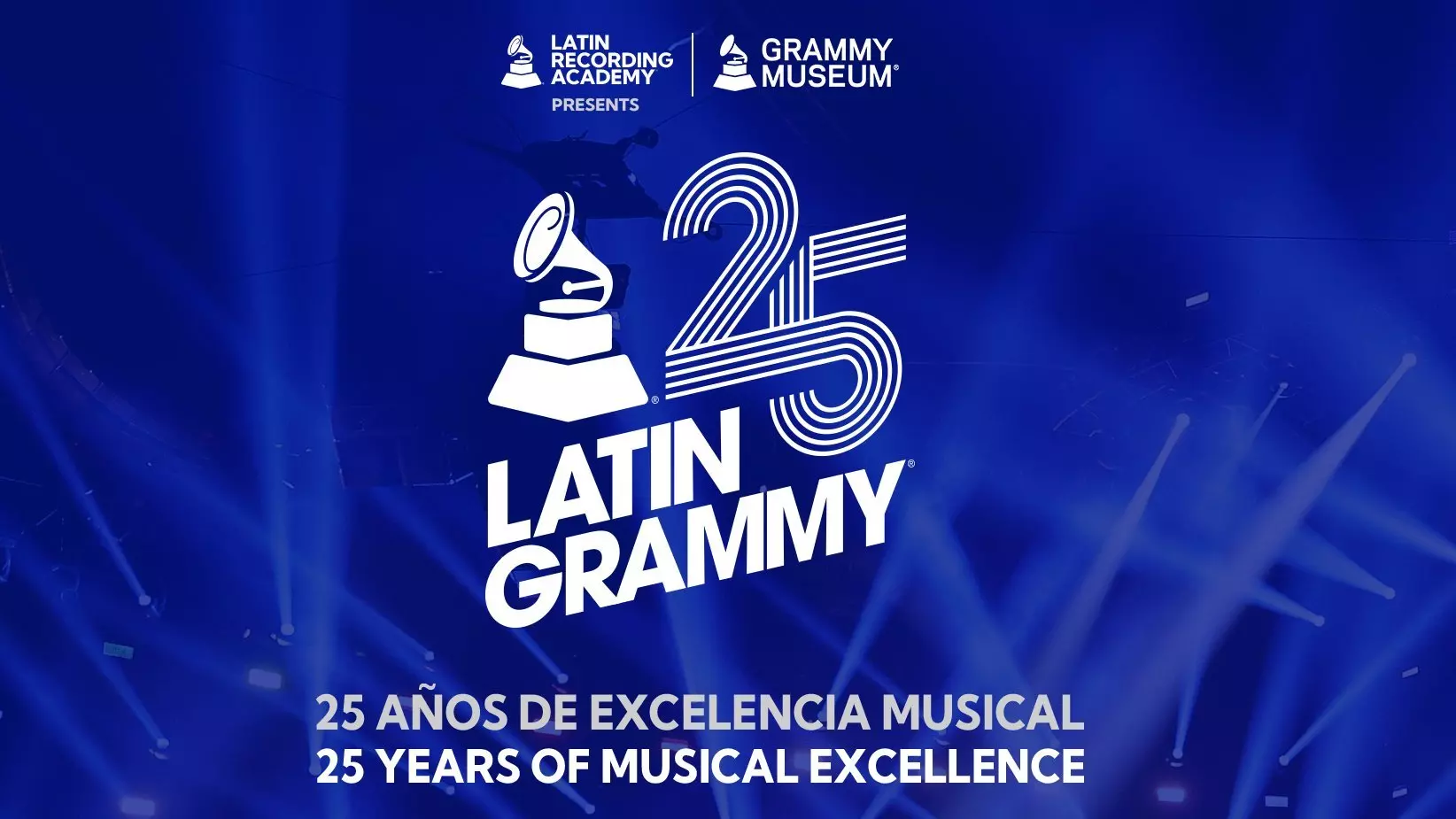
New Latin Recording Academy Exhibits In New York, Los Angeles & Miami To Celebrate The 25th Anniversary Of The Latin GRAMMYs: Launching September 2024

Latin GRAMMY Cultural Foundation Awards Prodigy Scholarship To Leo Luna Roblejo & Announces More Tuition Scholarship Recipients

The Latin Recording Academy Announces 2024 Special Awards Recipients: Los Ángeles Azules, Draco Rosa, Albita, Lolita Flores & More
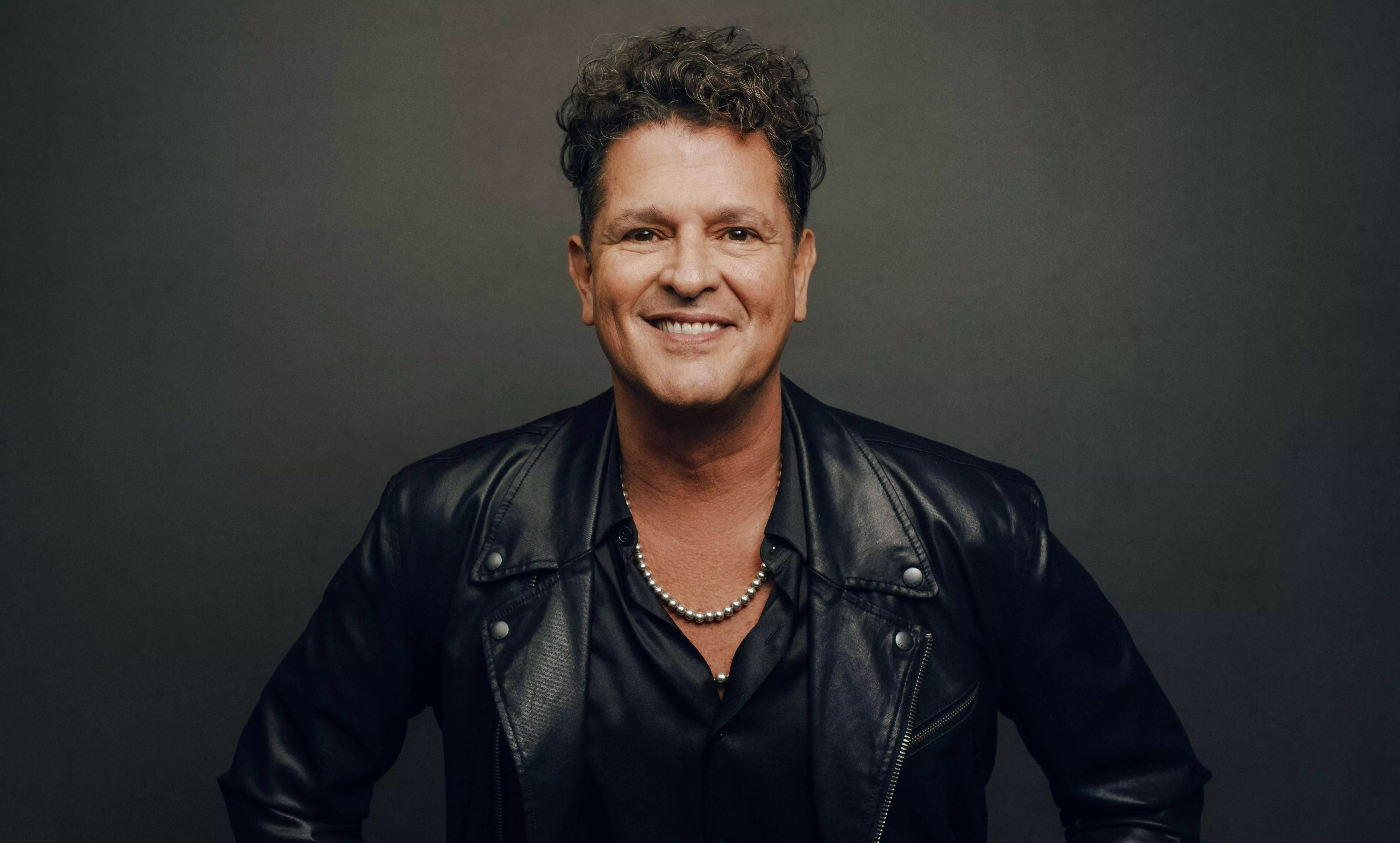
Carlos Vives Named The 2024 Latin Recording Academy Person Of The Year: What To Know About The Latin Music Icon

2024 Latin GRAMMYs To Take Place Thursday, Nov. 14, In Miami; Nominations To Be Announced Tuesday, Sept. 17

Photo: Arenovski
feature
Peso Pluma's Road To 'ÉXODO': The GRAMMY Winner Navigates The Consequences Of Global Stardom On New Album
"Fans really get to see the other side of the coin; there are two sides to me. It's darker, rawer," Peso Pluma says of his latest album 'ÉXODO'
Peso Pluma marked his musical destiny with a Tupac tribute tattoo in the center of his clavicle: "All Eyez On Me."
The Mexican artist, born Hassan Emilio Kabande Laija, doesn't remember exactly what year he inked his chest. He knows it was well before his debut in music. Those four words reflected Peso's irrefutable confidence that the world's eyes would eventually be on him.
The world's eyes are indeed on Peso Pluma. In less than two years, the singer achieved global fame by singing corridos tumbados, traversing a path never before trodden by a música Mexicana artist.
At 25, Peso Pluma is at the forefront of a new generation of música Mexicana artists that have successfully modernized traditional Mexican rhythms, such as corridos, by infusing them with elements from urban music and a hip-hop aesthetic. The weight of representing an entire genre and a country could be great for some. But pressure doesn't affect Peso Pluma; on the contrary, it motivates him to keep working to exalt his roots.
"We've come a long way, but we still have a long way to go. And that doesn't mean we have to slow down; it doesn't mean everything is over. This is the beginning of everything," Peso Pluma said in a TikTok video before a performance at the Toyota Arena in Ontario, Canada, a little over a year ago.
Out June 20, Peso's extensive new album ÉXODO seeks to cement his global star status further. Over 24 tracks, the singer continues to explore corridos tumbados and digs into his urban side via much-awaited collaborations with reggaeton and hip-hop icons. Among those big names is Peso's teenage idol, the American rapper and producer Quavo, as well as further afield collaborations with Cardi B.
"ÉXODO is a project I've been working on for over a year before we even won the GRAMMY. GÉNESIS was an incredibly special project, and I knew we couldn't make the same diamond twice," the singer tells GRAMMY.com in a written interview.
Peso Pluma's path to the global stage has been lightning-fast. While he started releasing songs in 2020, Peso will remember March 2023 as the month that propelled him into global mega-stardom. His collaboration with Eslabón Armado on "Ella Baila Sola" led him to become a household name outside his native Mexico.
The hit resonated with an audience eager for new sounds, accompanying social media videos and surpassing a billion streams on Spotify. "Ella Baila Sola" became the first Mexican music track to top the platform's global chart. On Billboard, it conquered No. 1 on the magazine's Global 200 chart for six weeks and reached the coveted No. 4 spot on the Hot 100 chart. The mega-hit took Peso Pluma and Eslabon Armado to make their Latin GRAMMY stage debut in November with an electrifying performance.
Another collaboration, "La Bebe (Remix)" with Mexican reggaeton artist Yng Lvcas, released a day after "Ella Baila Sola," also contributed to Peso Pluma's virality in a completely different genre, but one in which he feels comfortable: urban music.
Learn more: Peso Pluma's 10 Biggest Collabs: From "Bzrp Sessions" To "Ella Baila Sola" &"Igual Que Un Ángel"
As Peso Pluma gained traction with a global audience, his February 2022 single with Raúl Vega, put him, for better or worse, on the map in Mexico. The warlike content of "El Belicón" lyrics and video clip attracted attention for the way it allegedly promoted narcoculture.
Despite growing criticism, Peso Pluma remained tight-lipped regarding references to high-profile members of the Mexican drug trade, as well as drug use and trafficking. In a rare admission to GQ magazine, the singer explained this is a "delicate subject to talk about, but you have to touch on it with transparency — because it's the reality of things."
"In hip-hop, in rap, just like in corridos, and other urban music like reggaeton, it talks about reality. We're not promoting delinquency at all. We're only talking about things that happen in real life," the singer explained.
With the success of "El Belicón" and "Ella Baila Sola" under his belt, Peso Pluma released GÉNESIS in June 2023. Despite being his third album, Peso considers it his true debut in music.
"I didn't want to delete my previous albums [Efectos Secundario and Ah Y Que?] because they represent my beginnings," Peso told Billboard in a cover story published a few weeks after the release of GÉNESIS. In the same conversation, the singer said he saw himself winning his first GRAMMY and breaking more records.
Read more: 5 Takeaways From Peso Pluma's New Album 'GÉNESIS'
In February 2024, Peso Pluma did just that. He took home the golden gramophone for Best Música Mexicana Album (Including Tejano) — his first GRAMMY Award. This victory didn't weigh on him as he approached his next production. "It pushed me to want to create something different that the fans haven't heard from me before," Peso Pluma tells GRAMMY.com.
While GÉNESIS and ÉXODO may differ in substance, they share similarities beyond music. That both records pull from the Bible for their names is not a random occurrence; the opening book of the Hebrew and Christian Bible delves into the genesis of creation, while the Book of Exodus explores the themes of liberation, redemption, and Moses' role in leading the Israelites through the uncharted waters of the Red Sea.
"ÉXODO is the continuation of GÉNESIS, which was the beginning," Peso Pluma explains to GRAMMY.com. "ÉXODO means new beginnings, a new era for me. We are preparing for the next chapter, and that's what we are doing for Mexican music, paving the way, laying the groundwork for what's next because it doesn't stop here."
His "sophomore" album is divided into two discs: the first is corridos, and the second is urban. It also continues the line of collaborations, with twenty tracks where Peso Pluma shares the limelight.
"Some of my fans were craving música Mexicana, and some were craving urbano, and I wanted to give them everything while still staying true to myself and choosing songs and lyrics that spoke to me," he continues.
ÉXODO's disc one starts with "LA DURANGO," the album's fourth single, featuring Eslabon Armando and Junior H. In the record, he also invites collaborators such as Natanael Cano and Gabito Ballesteros for "VINO TINTO" and Mexican rising star Ivan Cornejo on the melancholic "RELOJ," among others.
For Side B, Peso enlisted heavyweights from the urban genre in the Anglo and Latin markets: Anitta in the steamy "BELLAKEO," Rich The Kid in the bilingual "GIMME A SECOND," and Quavo in the existential trap "PA NO PENSAR." Cardi B, Arcángel, Ryan Castro, Kenia OS, and DJ Snake complete ÉXODO's genre crossover.
In ÉXODO, luxury, drugs, alcohol, and women continue to take center stage in the lyrics, accompanied by fast-paced guitar-driven melodies and reverb-dense vocals. However, the production sheds light on the vulnerable side of Peso and explores the unexpected consequences of becoming globally famous.
"Fans really get to see the other side of the coin; there are two sides to me. It's darker, rawer," Peso says about the record.
In the songs "HOLLYWOOD" and "LA PATRULLA," for example, Peso details how this musical path keeps him up at night, as well as his aspirations, and how he remains the same despite his success.
Perhaps one of the deepest and rawest songs on the album is "14:14," a track inspired by the Bible verse 14:14 from the Book of Exodus, which, the singer explains, was fundamental amidst the turbulence he faced on the way to global stardom.
"[The] verse 14:14 says 'The LORD will fight for you; you need only to be still.' This verse couldn't be truer," Peso Pluma says. "Over time, I learned to really trust in this and believe that some things are not up to me and I should trust the process."
In the song — one of the few on the album without a collaboration — Peso references the challenges of his profession and how his faith has kept him afloat amid the vicissitudes. "Things from the job that no one understands/I hide the rosary under my shirt so I don't poison myself, so I don't feel guilty/because whatever happens, the Boss will forgive me," he sings.
In "BRUCE WAYNE," Peso Pluma croons about the passionate feelings his career arouses: "First they love you, and then they hate you/wishing the worst, envy and death," the song says.
The singer resorts to comparing himself to a superhero figure again. In an unusual twist, Peso crosses comic universes, moving from his now traditional reference to Spider-Man to one from the DC Comics world: Bruce Wayne, Batman's secret identity. A wealthy man, part of Gotham's high society, Bruce Wayne is known for transforming his darkness into power while remaining reserved and isolated.
"Everyone has two sides of them, even me," Peso tells GRAMMY.com. "Peso Pluma on stage is a high-energy person, someone who is powerful and dominates a show and isn't afraid of anything. And then there is Hassan, who's chill and more relaxed and who deals with all the realities of life."
During the year and a half it took him to complete ÉXODO, Peso Pluma had to deal with the diverse nuances of a global star's life, including a widely publicized breakup from Argentine rapper/singer Nicki Nicole, the cancellation of one of his shows in October 2023 after a Mexico drug cartel issued a death threat against him, and a media frenzy over his alleged admission to a rehabilitation clinic, the latest a rumor he laid to rest during a March interview with Rolling Stone for his Future of Music cover story.
"The reality is, all these days, I've been in the studio working on ÉXODO," the artist explained to Rolling Stone.
Most of 2023 was a successful balancing act for Peso Pluma, who combined touring, an album release, rare media engagements, two Coachella appearances, all the while developing another record. According to the singer, ÉXODO was created in Los Angeles, Miami, New York, and Mexico. "We go to the studio everywhere!" Peso says. "It doesn't really matter where we are; I love to get into the studio and work when we have free time."
Like GÉNESIS, ÉXODO will be released via Peso Pluma's Double P Records, of which he is the CEO and A&R. Much of the talent the Mexican singer has signed to his label took part in the album's production, and songwriting process.
"For the Mexican music side, I had the whole [touring] band with me; I like to have them involved in the process so that we can all give our input on how it sounds, discuss what we think needs to be changed, create new ideas," he explains.
Peso Pluma knows that echoing the success of 2023 is no easy task. He was the most streamed artist in the U.S. on YouTube, surpassing Taylor Swift and Bad Bunny, and was the second most-listened to Latin artist in the country, amassing an impressive 1.9 billion streams, according to Luminate.
Música Mexicana emerged as one of the most successful genres in 2023, witnessing a remarkable 60 percent surge in streaming numbers, adds Luminate's annual report, crediting Peso Pluma along Eslabon Armado, Junior H, and Fuerza Regida as part of this success.
Collaborations on and off the mic have undoubtedly played a significant role in the rise of Música Mexicana on the global stage. Peso knows that the key to continuing onward is teaming up with renowned artists inside and outside his genre.
"All of us coming together is what pushed música Mexicana to go global," the singer affirms. "We showed the world what Mexico has to offer, and now no one can deny the power and talent we have in our country."

Photo: Mia André
interview
Crashing Into The Present: How Kehlani Learned To Trust Their Instincts And Exist Loudly
"I want this next batch of music to feel like the most fiery parts of me," Kehlani says of her new album, 'Crash.' The singer/songwriter speaks with GRAMMY.com about embracing the moment and making an album she can headbang to.
After finishing the first mixes of their new album, Kehlani knew exactly what she needed to do: head to Las Vegas.
The L.A.-based, Oakland-born singer/songwriter had always identified with Sin City: "I’m full of juxtapositions," she tells GRAMMY.com. "Vegas is this crazy bright light city in the middle of a vacant desert that has weddings and also strippers." Fittingly, Kehlani harbored a very Vegas-like image in their head while creating Crash, a record built on blaring neon, glowing smoke, and the highest highs.
Crash drops June 21, and is Kehlani's fourth solo album. She burst onto the scene in 2009 as a member of teen sextet PopLyfe, but their 2014 debut solo mixtape Cloud 19 announced a far more complex character. Their debut full-length, SweetSexySavage, was released three years later to critical acclaim, with two more albums and a handful of platinum-certified singles following. As if that weren’t enough, Kehlani added acting, appearing in "The L Word: Generation Q" and a cameo in Creed III.
And while Crash embodies the evolution and growth through all those experiences, the record builds a hyper-real language all their own. Beyond any sense of R&B or pop, soul or hip-hop, Crash finds Kehlani chasing passions that refuse to fit in any box, shifting multiple times within a track — refusing to focus on anything but the moment.
"A crash isn't anything from the past. It isn't the anxiety of what's about to happen," she says. "It's the height of the moment. It's right now."
Nearing the release of Crash, Kehlani spoke with GRAMMY.com about finding inspiration from international music, getting their five-year-old to sing on the album, and their need to stage dive.
What’s it like living in Los Angeles after growing up in the Bay Area?
I moved to L.A. when I was about 17. I had already left the house. I left the house at 14, and by the time I was almost 18 it was the appropriate time for me to situate in a new place. L.A. and the Bay are like cousins. Do we have differences? Absolutely, things that are fundamental to us, but when you leave California, you can really see that we're just like a big family.
Had you been dreaming of L.A. as a place where you could pursue art? Were you already set on that goal?
It was the closest place that a young, very broke person could go and work in music. I'm sure there were other places with musical homes, musical cities, but if all I had to do was get on a $15 bus and go find someone to stay with in L.A., I was gonna do it for sure.
That’s the same ambition that I feel drives this new record, which is just so dense and full of surprises. That includes the lovely retro radio intro to "GrooveTheory," where you move from this ‘60s pop feel to the present. That’s such a smart way to foreground your evolution.
I think the second that we made that song and then turned it into ["GrooveTheory"], I was like, This feels like it encompasses where I'm headed, this whole new sound.
Once that radio dials in and it comes in with R&B elements, it's producing where I'm headed, but also remembering that my core hasn't changed. Especially the energy of what I'm saying in the song, like, "I'm kind of crazy," it's introducing this energy difference on this album. I feel like that's the biggest change, and that's what's so prevalent in this whole rollout. Energetically, I'm on a whole different type of time.
You can sense it. 'Crash' feels really rooted in self-expression and personal growth, and when you listen to it as a whole, it really does seem like an evolution story. Beyond just the genre and style, how do you feel the way that you've expressed your true self has shifted over the years?
Thank you! That's been the feedback I've gotten from pretty much everyone who's listened, and I don't know what I expected, but it wasn't this. I have realized the public's understanding of me and the general consensus for so long, and I also realized how multi-faceted I am to people.
People get really confused when I express all the sides of my personality. They’re either, like, "Okay, she makes really sweet love songs," or "We've seen you be political, we've seen you come out, we've seen you be a family member." And then there's a lot of people who are, like, "I feel like she's f—ing crazy. I've seen her in multiple relationships. I've seen her be angry. I've seen her get online and cuss people out."
I want this next batch of music to feel like the most fiery parts of me. I want it to feel like the most present and energetic parts of me. I don't want anything to feel somber. I don't want anything to feel reminiscent. I think a lot of my albums in the past have been me looking back, and sitting in that feeling and detailing it. I just wanted [this album] to feel right here, right now, which is why the title came about. A crash isn't anything from the past. It isn't the anxiety of what's about to happen. It's the height of the moment. It's right now.
That’s unfortunately a story you hear too often about artists of color — that essentialization, where you can only be seen as one thing. R&B often gets hit with those same issues. Throughout your career you’ve stood up to those expectations, and "Better Not" on this album is such a good example of that. It’s a left turn, a stylistic contrast and an open conversation with the listener. You cleverly fuse that intentionality with a voice that’s stronger than ever.
In the past, I have had moments where I would make the song and [start recording], and there would be so many versions of each song on different microphones, recorded in different places.
"Let me try vocal production. Let me try to go back and work with this version again." I went back and did vocal production with Oak Felder, who did all the vocal production on SweetSexySavage. When I come back to some of my favorite vocal production moments, it was moments like "Distraction" or "Advice" or "Escape" — songs on my very first album — and I wanted to get that feeling again. Where it's lush where it needs to be, but also that I really mean what I'm saying.
That started with the approach in the songwriting. Once I had the songs and I had to go back and deliver them, I had enough time to listen and listen, to learn the songs and identify with them. We would make music all day and then go out, and we would be in this sprinter van on the way to going out, and, like, bang, the songs we just made, the energy was just different. It allowed me to be present in a different way where my voice is able to show up like that.
Which again ties perfectly to crashing into the present. As someone from South Africa, I love that the other guests that you included represent different cultural viewpoints. You worked with Young Miko from Puerto Rico, Omah Lay from Nigeria. Having that musical dialogue is so powerful.
We had so many conversations about how America's in the backseat often when it comes to music. We have our moments, and it's fantastic, like Beyoncé’s Cowboy Carter. There's a culture that is super American, that is Black, that historically needs to be dived into. It needs to be shown that we do have something here.
So many people that don't speak Spanish bang Bad Bunny all day. Amapiano’s taking over; Tyla’s going up. It's really not here. So that wasn't a conscious choice. It's just what we've all been listening to, what we've been loving.
Read more: 11 Women Pushing Amapiano To Global Heights: Uncle Waffles, Nkosazana Daughter, & More
Speaking of guests, I wanted to ask about your daughter, whose voice is on "Deep." Was she just in the studio and you got her singing?
So those vocals on that, that’s actually my little sister and my goddaughter. And [my daughter] was in the room and she started singing along. She has perfect pitch; she's always freestyling or singing or making something up.
I was like, "You want to just go sing on it?" What's on there is her first take. Literally. She did it the first time, all the way through, perfectly. I was like, "Well, that's it, guys. I can retire."
That track is so lush. It feels so alive. Were you working with a full band?
[Producer] Jack Rochon, who I did a lot of the music with, he just is a freaking genius music whiz. Honestly, he's one of the most humble people that I know, and deserves credit for how amazing a lot of this album is.
Talking about touchstones, there's a Prince energy to the title track. Did you have any new inspirations or influences for this record?
Thank you! My main focus for this album came from going on tour for my last one and making such a pretty, sweet, intimate album, and then playing some of the biggest venues of my career. At some point I had to rearrange the setlist to add in a lot of the album before that one, because it was just more energy on the stage. By week two of tour, the setlist had completely changed. I knew that I was playing venues on this next tour that I've dreamt about, places that I can't fathom that I'm playing, like Barclays Center.
I do a lot of things for, like, my inner child, and this is such a move for my inner child. Like, You're about to go play Barclays. Do you want to look back and say, ‘I rocked out and played Barclays’? I'm a person who headbangs on stage. I stage dive. I wanted to create an album that would ring through a venue like that. I want people to be engaged again. I'm not looking for the lighters and the somber, holding each other — which will occur regardless, because it's a me show.
But I really wanted people to be in their bodies, and their heart’s exploding and the ground’s shaking. So that's what we accomplished. I wanted to have fun. This album is so fun to me. It’s a place of fire in my heart.
It took me a second to get the word play on "Eight." I loved the track, and then suddenly I was like, 'Oh… I knew there was something raunchy going on here.'
[*Laughs.*] "Eight" was super fun, and shoutout to the boys that I did it with, because they made it everything for me.
I didn't come up with the wordplay. My boys did. Like, "This is how you talk!" I was like, "It is! This is perfect." Once I got in to fix things, add things, add my own spin, and finish writing, my favorite part was that it sounds like a Brandy song. She's my favorite.
I also wanted to ask about the Nina Sky sample on "After Hours."
That was mine. I was like, "What can we flip that when it comes on, my generation loses their mind?" And for me, every single time that Nina Sky comes on in the club, everybody's like "Woo!" And then you see how many songs were made from that same sample, and they're all songs that make us lose our minds.
I went into the room with the producers, and I was like, "So, I want to flip this, but I want you to make it to where it doesn't become one of those where the whole thing is just a sample."
Similarly, "Lose My Wife" balances breeziness with high emotional stakes. Is finding a balance like that just natural for someone so capable of juxtaposition?
The second that we established that [the record] felt like Vegas, I knew what components were missing from the energy of how I feel the second my car crosses the line into the city of Las Vegas. I knew I was missing that feeling of the next morning when you realize you went on this high and you come down. I wanted to create these scenarios that weren't necessarily applicable to me, but captured that emotion. I've been there before, and I want people to be like, Damn, I've been there before. I know this feeling.
I recorded that song at 4 in the morning with a sinus infection. The second that we finished it, everybody was like, "You can never re-sing that. Don't try to make another version, you're not gonna be able to sound like that again." All the chatter in the background of that song is really everybody who was in the studio that stayed up to just hang out. We had the tequila out, it was perfect. That was probably one of my favorite moments of making the album.
It takes a while as an artist to reach a place where you can capture those moments. You said before that people try to figure you out, and I mean this in the best possible way, but it feels like now you don’t care if they can’t figure you out.
I don't give a f—anymore, yeah. And that was a very important thing for me to learn. I used to care so much, and I would spend so much time explaining myself online, in music, in interviews, on stage. I realized that you're damned if you do, damned if you don't.
I've been so forward-facing with my heart my entire career that I've left a lot of room for people to consistently pedestal me and then critique me, for people to want to tear me down. I realized I'm just being present, here, existing loudly in front of a billion people, and whichever way that goes is how the cookies gonna crumble. Me giving a f—? I'm the only one it's affecting at this point, for sure.
Angélica Garcia's Intuition: How 'Gemelo' Was Born By Embracing L.A., Ancestry & Spanish Language
